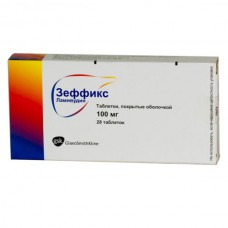Expiration date: 01/2026
Composition and form of issue:
Tablets, film-coated. 1 tablet contains:
lamivudine 100 mg
excipients: microcrystalline cellulose sodium starch of glycolate magnesium stearate hypromellose titanium dioxide macrogol 400 Polysorbate 80 iron oxide yellow and red
in a contour acheikova packing 14 PCs., in box 1, 2, and 6 packs.
Description of dosage form:
Tablets: film-coated yellowish-brown, capsule-shaped, biconvex, engraved with the inscription "GX GG5" on one side of the tablet.
Solution for oral administration: transparent, from colorless to pale yellow, with a fruity smell.
Pharmacological action:
It has a high activity against hepatitis b virus (HBV).
In both infected and uninfected cells, lamivudine is metabolized to lamivudine triphosphate, which is the active form of the drug. In vitro, the half-life of lamivudine triphosphate in hepatocytes is 17-19 h. Lamivudine triphosphate is a substrate for DNA polymerase of hepatitis b virus. the Inclusion of lamivudine triphosphate in the chain of viral DNA and the subsequent break of the chain block the further formation of viral DNA. Lamivudine is a weak inhibitor of &,alpha - and&, beta-DNA polymerases of mammals.
In studies to determine the possible effect on the structure of mitochondria, as well as on the content and function of DNA, lamivudine was not revealed significant toxic effects. Lamivudine has a very weak ability to reduce the content of mitochondrial DNA, is not included, as a rule, in the chain of mitochondrial DNA and does not inhibit &,gamma-polymerase of mitochondrial DNA.
Zeffix has a pronounced antiviral activity in vivo and quickly suppresses the replication of HBV after treatment.
Indications:
Chronic hepatitis B against the background of hepatitis b virus replication.
Contraindications:
Hypersensitivity to lamivudine or to any other component of the drug, pregnancy (I trimester).
Caution should be used in renal failure, pancreatitis (W. in history), peripheral neuropathy, pregnancy (II–III trimester), lactation, children's age (up to 2 years).
Use during pregnancy and breast-feeding:
There are limited data on the safety of lamivudine during pregnancy. Studies in pregnant women have shown that lamivudine penetrates the placenta. The serum concentrations of lamivudine in newborns at birth were the same as in maternal serum and umbilical cord blood.
Although the results of studies in animals are not always prognostic for humans, these studies in rabbits suggest a possible risk of spontaneous abortion in early pregnancy under the influence of lamivudine.
The use of lamivudine during pregnancy is possible only when the expected benefit to the mother exceeds the possible risk to the fetus. If pregnancy occurred during treatment with Suffixes, it should be borne in mind that after discontinuation of the drug may develop an exacerbation of hepatitis B.
After oral lamivudine concentrations in breast milk were similar to its concentration in serum (1-8 mg/ml). Studies in animals suggest that lamivudine in breast milk has no toxic effects on breast-fed children.
Side effect:
The most common side effects are General malaise and fatigue, respiratory infections, headache, discomfort and abdominal pain, nausea, vomiting and diarrhea.
The frequency of changes in laboratory parameters in patients with chronic hepatitis B is similar with the use of Zeffix and placebo, with the exception of a more frequent increase in ALT after completion of therapy with Zeffix. However, a significant difference in the frequency of increase in ALT levels, combined with an increase in the level of bilirubin and/or with signs of liver failure, is not detected. It is not known whether these cases of exacerbation of hepatitis are associated with treatment with Zeffix or with the peculiarities of the course of the most chronic hepatitis.
In patients with HIV infection, there were cases of pancreatitis and peripheral neuropathy (or paresthesia), but the relationship of these complications with lamivudine therapy has not been proven. There was no significant difference in the frequency of these complications in the groups of patients with chronic hepatitis B, taking Zeffix and placebo.
In patients with HIV infection, receiving combined therapy with nucleoside analogues, there were cases of lactic acidosis, which is usually accompanied by severe hepatomegaly and fatty liver dystrophy. There were sporadic reports of such adverse effects in patients with viral hepatitis b and hepatic insufficiency, however, no data confirming the relationship of these complications with Suffixes.
Dosage and administration:
Inside, regardless of the meal.
Adults and children 12 years and older: 100 mg once a day.
Children from 2 to 11 years: 3 mg / kg 1 time per day, but not more than 100 mg/day.
Children under 2: there is insufficient data to recommend dosages in this age group.
Data on patients on hemodialysis (dialysis sessions 2-3 times a week &, le4 h), show that after the initial reduction in the dose of Zeffix in accordance with creatinine clearance, further throughout the period of hemodialysis additional dose adjustment is not required.
Liver failure: in liver failure, if it is not accompanied by renal failure, does not require correction of the dose of lamivudine.
Overdose:
In experiments in animals, the introduction of very high doses of lamivudine did not have a toxic effect on the organs. There are limited data on the effects of acute overdose of lamivudine in humans. No fatal cases were reported after overdose, and the condition of all patients returned to normal. No specific signs or symptoms of lamivudine overdose have been described.
In case of overdose, it is recommended to monitor the patient's condition and conduct standard maintenance therapy. Since lamivudine is excreted by dialysis, with an overdose of the drug, continuous hemodialysis is possible, but no special studies have been conducted.
Precautionary measures:
During treatment with Zeffix, the condition of patients should be regularly monitored by a doctor with experience in the treatment of chronic hepatitis B.
After cessation of treatment with Suffixes some patients with chronic hepatitis b revealed laboratory or clinical signs of exacerbation of hepatitis that may have particularly serious consequences for patients with hepatic failure.
After discontinuation of treatment with Zeffix, it is necessary to periodically monitor the General condition of patients, as well as monitor the performance of functional liver tests (ALT and bilirubin levels) for at least 4 months to identify signs of a possible exacerbation of hepatitis. In the future, patients should be observed according to the indications. Currently, there is not enough convincing data on the effectiveness of re-treatment with Zeffix in those patients who, after discontinuation of therapy, had an exacerbation of hepatitis.
In the treatment of patients with co — infection-HIV and chronic viral hepatitis B (CVH - B), who receive or will receive treatment with lamivudine or lamivudine/zidovudine, it is necessary to maintain a dose of lamivudine, prescribed for the treatment of HIV infection (usually 150 mg 2 times a day).
Currently, there is no information about the effect of lamivudine on transplacental transmission of HBV. It is recommended to carry out a standard procedure for immunization of newborns against hepatitis B.
Patients should be warned that treatment with Zeffix does not reduce the risk of HBV transmission to other people and therefore appropriate precautions should be taken.
Patients with diabetes should be aware that each dose of Zeffix of oral solution (100 mg = 20 ml) contains 4 g of sucrose.
Special studies of the effect of lamivudine on the ability to drive and work with equipment has not been conducted. Pharmacological properties of the drug do not suggest the presence of such an effect.
Additional data
If during treatment, patients cannot Noad of seroconversion to anti-HBe, then after 2-6 months after discontinuation of therapy Suffixal resumes replication of HBV and increases the content of viral DNA and of serum transaminases to levels observed before treatment.
Patients with hepatic insufficiency caused by chronic hepatitis B were prescribed Zeffix before, during and after liver transplantation to suppress hepatitis b virus replication.
Currently, there are no clinical data on the effectiveness of Zeffix ® in patients younger than 16 years, as well as in patients with co-infection/superinfection with D-virus. Subpopulations of HBV with reduced sensitivity to lamivudine in vitro (YMDD strains) were found. Despite the emergence of YMDD strains of HBV patients who took Zeffix for one year had significantly lower serum levels of HBV DNA and ALT and a better histological picture compared to patients taking placebo. After 2 years of treatment with Zeffix in patients with ymdd strains of HBV serum concentrations of HBV DNA and ALT remained at a lower level than before treatment. The safety profile of Zeffix was similar in patients with and without ymdd HBV strains. YMDD HBV strains appear to have less ability to replicate in vitro and in vivo and may therefore be less virulent than the wild HBV strain.


